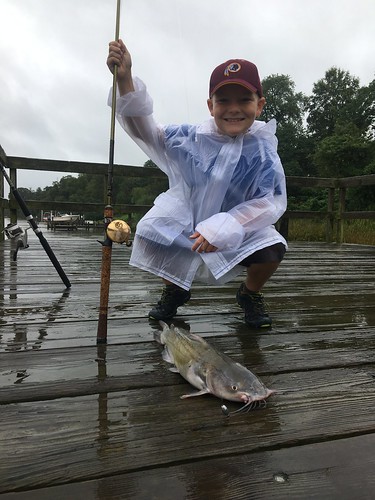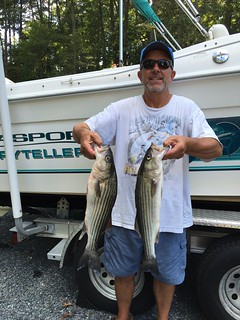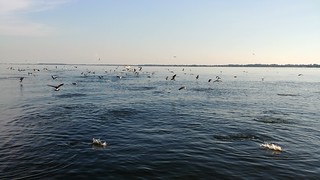Maryland Fishing Report: September 12

Young Isaac rose to the occasion when grandad asked if he wanted to go fishing in the rain, and he loved every minute of it. Photo by Eric Packard
Living close to the water gives one an interesting perspective on impending storms. At ports all-around the bay and coastal areas, boat owners have been lining up at boat ramps and moving their vessels to safer areas. Low-lying areas can expect flooding and it sounds like we may in for some more rain, which is nothing new. Please pay close attention to the forecast and any safety advisories issued for Maryland waters before fishing this weekend.
The fact is most fishermen seem to have a disdain for fishing in the rain but others just make the most of it — the fish don’t care, since they’re already wet.
Forecast Summary: Sept. 12-18
What a difference a week makes. Last week, the Maryland portion of the bay was experiencing the warmest water temperatures of the season. Several days of cool, rainy and windy weather have caused water temperatures to plummet to more favorable conditions for rockfish. At the NOAA Buoys, water temperatures have dropped 8-12 degrees, with Annapolis now at 75 degrees, Gooses Reef at 78 degrees and Point Lookout at about 80 degrees.
With rain likely for the next few days, the fishing pattern will change from last week. Anglers should continue to seek the best combination of clear, cool, oxygenated waters. However, since the water column will be more uniformly mixed, there will be plenty of cool, well oxygenated water from the surface down into deeper waters for hungry gamefish to roam.
Expect poor water clarity from the high flows coming from most rivers and streams. The Susquehanna River’s muddy water will likely extend below Swan Point as the week progresses. There will be above average tidal currents through Saturday as a result of the new moon on Sept. 11.
For the full weekly fishing conditions summary and more detailed and up-to-date fishing conditions in your area of the bay, be sure to check out Eyes on the Bay’s Click Before You Cast.
Conditions certainly were not favorable for fishing this past weekend, with wind and rain prevailing. The winds have slowed for the time being and fog is making navigation spotty, as floating debris is difficult to spot. The waters are stained, tides are very high so most likely more floating wood will drift off shorelines into the bay, so be careful out there. The good news is the striped bass fishing is very good.
The channel edges of Swan, Love and Podickory points have been holding striped bass at about 20 feet. Live lining spot has been the most popular way to catch the larger fish and chumming or chunking a close second. The bridge piers at the Key Bridge and the Bay Bridge have also been good places to target striped bass suspended at about 20 feet near the bridge piers. Jigging with soft plastics has also been productive and now that breaking fish are being spotted, jigging underneath is always a good option for larger striped bass.
There are a lot of small striped bass in the upper bay region this week, and that is a good thing. They can be spotted now and then chasing schools of bay anchovies. They offer some fun catch-and-release topwater action with light tackle. This is a taste of what we can expect later on this month and into October as bait fish such as bay anchovies and juvenile menhaden leave the tidal rivers and get swept down the bay by tidal currents. This would be a good time to check on your inventory of metal jigs and the condition of your braided line.
Spot can still be found this week in some of the upper bay tidal rivers. The Magothy and the Chester rivers have been holding spot on hard bottom in about 15 feet of water. The west side of the Bay Bridge in 15 feet of water has also been holding spot. White perch fishing in deeper waters on hard bottom with bait has been very good in the tidal rivers. Shrimp, bloodworms, small minnows and peeler crab have been excellent baits to use. Channel catfish are also in the same areas and some are quite large.

Herb Floyd holds up a pair of striped bass he caught in the lower Choptank while live lining spot. Photo by Rhonda Floyd
The middle bay region is beginning to show signs that summer is fleeting. In one week the surface temperatures in the bay have dropped more than 10 degrees. This is mostly due to rain and cooler air, and although these temperatures may bounce back some, a trend is beginning. Breaking fish are being spotted and although most of the surface action is small striped bass, it is a positive sign.
Larger striped bass are being found suspended at about 20 feet along channel edges. Jigging can be effective when fish are spotted on a depth finder, but live lining tends to be the most popular and productive way to catch a nice grade of striped bass. Most are slowly checking out channel edges along the shipping channel and edges at the mouths of the region’s tidal rivers. The spot can be found in the tidal rivers on hard bottom in about 15 feet of water.
Trolling along the shipping channel edges has been an effective way to fish for Spanish mackerel this week. Small spoons pulled behind planers has been the ticket to catching some of these fine eating fish. Placing a bucktail or swimshad in the trolling spread can also account for a striped bass now and then.
The recently exciting red drum fishery may have seen its better days, as things seem to be winding down this week. Boats continue to cruise the area from the Southwest Middle Grounds to the Northwest Middle Grounds but have come up empty for the most part. A few cobia are being caught by sight fishing, trolling or jigging, but most are shy of the 40-inch minimum.
Trolling has been a good option for a mix of Spanish mackerel and bluefish in the 3-pound to 5-pound size range. Small spoons and hoses pulled behind planers has been the preferred method of trolling. A few striped bass are also being caught now and then. The catches of medium-sized Spanish mackerel have been a nice bright spot for fishermen in the lower bay.
Breaking fish are being encountered in the lower bay region from the mouth of the Potomac River east to Tangier and Pocomoke sounds. Most of the surface action is a mix of bluefish, Spanish mackerel and small striped bass. Casting metal is a fun way to fish these breaking fish with light tackle.
Live lining spot along the channel edges of the lower Potomac River near St. Georges Island and other steep edges in the area. The mouth of the Patuxent River also offers some live lining opportunities. Spot seem to be everywhere in the lower Potomac and Patuxent in about 15 feet of water over good hard bottom. The spot are getting larger and more than a few are large enough to fillet and wind up breaded and in a skillet. Croakers, white perch and sub-legal sized sea trout can also be part of the mix. Tangier Sound and Pocomoke Sound also offer a lot of bottom fishing action.
Recreational crabbing is about as good as it gets this week. In all three regions of the bay, the crabs are heavy and very active on baits. Fresh chicken necks tend to do fine and razor clams are like candy to blue crab.
The western region received a healthy dose of heavy rains and flooding and more is in the forecast. Many of the western region streams and rivers hit high flood stages, including the Savage River, upper Potomac River and Bear Creek. Maryland Natural Resources Police has issued a safety advisory to avoid boating and other recreational activity on the upper Potomac River until further notice.
The fall trout stocking program is quickly approaching and trout anglers can expect stocking to begin on the second week of October. Hatchery managers’ report that the trout to be stocked are noticeably larger this fall due to above-normal water flows at the hatcheries. The stockings will be announced on the trout stocking website and through our email newsletters.
 Some highlights of recent summer stocking include:
Some highlights of recent summer stocking include:
On Aug. 6, the North Branch Potomac River was stocked with 2,852 rainbow trout within the Barnum stretch of the river downstream of the Jennings Randolph Lake dam. These fish were considered “put and grow” size, and will provide recreational fishing opportunities as they grow larger.
Broadford Lake was stocked July 24 with 75 hybrid striped bass, 9 to 10 inches in length that were raised in an indoor closed system at the Meadow Mountain Youth Center. Piney Reservoir was stocked with 1,142 hybrid striped bass, 3 – 4 inches, from Chalk Point Aug. 1. Previous stocking has shown good growth and survival providing unique fishing opportunities in western Maryland.
About 9,200 largemouth bass, produced at Joseph Manning Hatchery in Brandywine were stocked in Mattawoman Creek, a major tributary of the Potomac River in Charles County. These fish were produced from wild broodstock that were collected from, and returned to, Mattawoman Creek. These advanced fingerlings tend to have higher survival rate than smaller fish and should recruit to the fishery within the next few years.
Also, the boat ramp at Unicorn Lake will be closed until further notice while work crews deploy a new, handicap-accessible floating pier at the boat ramp. The closure is not expected to last too long and staff there will notify us when the work is completed.
As a final note on the freshwater scene, Bloede Dam in the Patapsco River was partially breached with explosives this week. Work will continue at the site through spring 2019. Images of the breach have been posted on the Maryland Department of Natural Resources Facebook page.
It’s hard to predict how long it will take for the rough seas to calm down, but one thing is certain — fishing is always a bit different after a healthy storm. Right now it will take a cement block to hold bottom in the heavy surf, but when it calms down we are hopeful that the kingfish will still be there. Just recently, the catches of kingfish in the mornings were very good, with an added mix of small bluefish, flounder, spot and a few pompano. The croakers seem to have moved on.
At the inlet there should still be some sheepshead and triggerfish around the south jetty and inside to the Route 50 Bridge. If the water stays clear, flounder fishing will be good. If the waters get cloudy, fishermen will have to take a break for a bit, until conditions improve after the storm.
Outside the inlet is predictably rough and no one with a respect for the ocean will be leaving the dock. Most will be doubling up lines and battening down the hatches. Late last week there was good fishing for chicken dolphin and a few gaffers along with some white marlin near the Rock Pile. There was an epic bite of large yellowfin tuna and gaffer dolphin at the Triple Wrecks area off New Jersey last week. One Ocean City charter boat made the journey to focus on white marlin, catching and releasing 50 of them in two days of fishing at the Hudson Canyon. These fish will have to pass us in the near future when they head south.
May good luck cast its shadow upon you in regards to intercepting them when they pass our shores, or in this case canyons or the 30 fathom line.
“The life of every river sings its own song, but in most the song is long since marred by the discords of misuse.” – Aldo Leopold
Keith Lockwood has been writing the Fishing Report since 2003 and has had a long career as a fisheries research biologist since 1973. Over the course of his career he has studied estuarine fishery populations, ocean species, and over a decade long study of bioaccumulation of chemicals in aquatic species in New Jersey. Upon moving to Oxford on the eastern shore of Maryland; research endeavors focused on a variety of catch-and-release studies as well as other fisheries related research at the Cooperative Oxford Laboratory. Education and outreach to the fishing public has always been an important component to the mission of these studies. Keith is an avid outdoorsman enjoying hunting, fishing, bird dogs, family and life on the eastern shore of Maryland.



